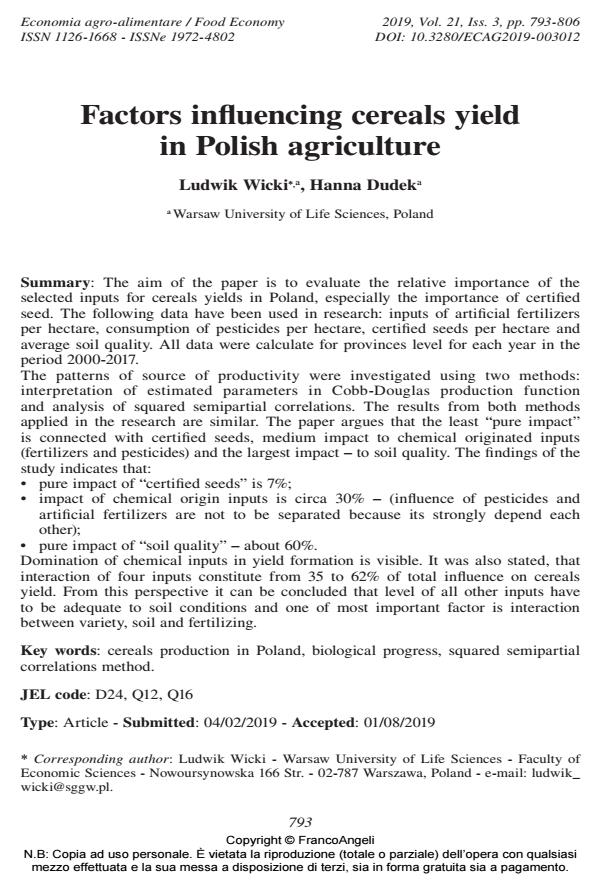Factors influencing cereals yield in Polish agriculture
Titolo Rivista ECONOMIA AGRO-ALIMENTARE
Autori/Curatori Ludwik Wicki, Hanna Dudek
Anno di pubblicazione 2020 Fascicolo 2019/3
Lingua Inglese Numero pagine 14 P. 793-806 Dimensione file 444 KB
DOI 10.3280/ECAG2019-003012
Il DOI è il codice a barre della proprietà intellettuale: per saperne di più
clicca qui
Qui sotto puoi vedere in anteprima la prima pagina di questo articolo.
Se questo articolo ti interessa, lo puoi acquistare (e scaricare in formato pdf) seguendo le facili indicazioni per acquistare il download credit. Acquista Download Credits per scaricare questo Articolo in formato PDF

FrancoAngeli è membro della Publishers International Linking Association, Inc (PILA)associazione indipendente e non profit per facilitare (attraverso i servizi tecnologici implementati da CrossRef.org) l’accesso degli studiosi ai contenuti digitali nelle pubblicazioni professionali e scientifiche
The aim of the paper is to evaluate the relative importance of the selected inputs for cereals yields in Poland, especially the importance of certified seed. The following data have been used in research: inputs of artificial fertilizers per hectare, consumption of pesticides per hectare, certified seeds per hectare and average soil quality. All data were calculate for provinces level for each year in the period 2000-2017. The patterns of source of productivity were investigated using two methods: interpretation of estimated parameters in Cobb-Douglas production function and analysis of squared semipartial correlations. The results from both methods applied in the research are similar. The paper argues that the least "pure impact" is connected with certified seeds, medium impact to chemical originated inputs (fertilizers and pesticides) and the largest impact - to soil quality. The findings of the study indicates that: - pure impact of "certified seeds" is 7%; - impact of chemical origin inputs is circa 30% - (influence of pesticides and artificial fertilizers are not to be separated because its strongly depend each other); - pure impact of "soil quality" - about 60%. Domination of chemical inputs in yield formation is visible. It was also stated, that interaction of four inputs constitute from 35 to 62% of total influence on cereals yield. From this perspective it can be concluded that level of all other inputs have to be adequate to soil conditions and one of most important factor is interaction between variety, soil and fertilizing.
Parole chiave:Cereals production in Poland, biological progress, squared semipartial correlations method.
Jel codes:D24, Q12, Q16
- Wykorzystanie metody DEA do analizy zmian produktywności i efektywności w zakresie produkcji zbóż według województw w latach 1997-2019 Urszula Grzybowska, Ludwik Wicki, in Metody Ilościowe w Badaniach Ekonomicznych /2023 pp.120
DOI: 10.22630/MIBE.2022.23.4.12 - THE ROLE OF TECHNOLOGICAL PROGRESS IN AGRICULTURAL OUTPUT GROWTH IN THE NMS UPON EUROPEAN UNION ACCESSION Ludwik Wicki, in Annals of the Polish Association of Agricultural and Agribusiness Economists /2021 pp.85
DOI: 10.5604/01.3001.0014.7880 - LAND AND LABOR EFFICIENCY CHANGES IN POLISH AGRICULTURE IN REGIONAL TERMS Joanna Bereżnicka, Ludwik Wicki, in Annals of the Polish Association of Agricultural and Agribusiness Economists /2023 pp.23
DOI: 10.5604/01.3001.0016.3035
Ludwik Wicki, Hanna Dudek, Factors influencing cereals yield in Polish agriculture in "ECONOMIA AGRO-ALIMENTARE" 3/2019, pp 793-806, DOI: 10.3280/ECAG2019-003012